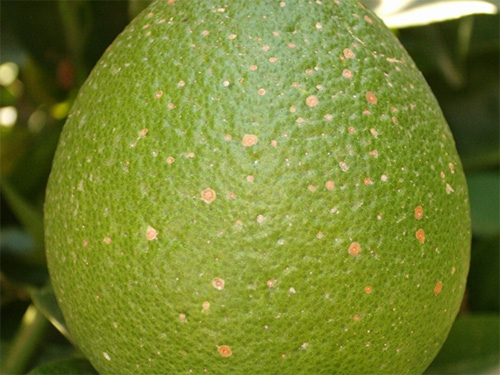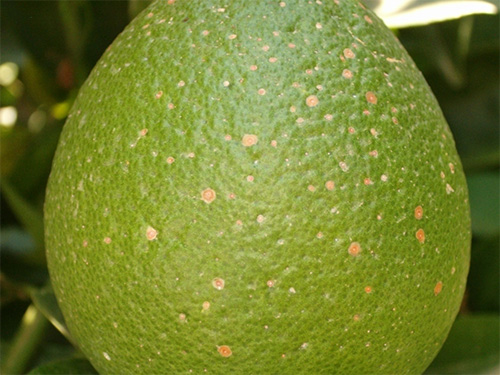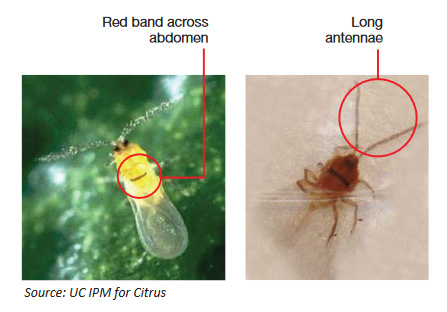


With spring approaching, the citrus industry in California will soon begin monitoring for California Red Scale. Now is a great time to review best practices for monitoring the pest.
DETERMINING WHEN TO MONITOR
California Red Scale males emerge during discrete flights. The number of male flights and generations can vary by geographic location, with typically four to five per year. Because of this potential variability, citrus producers and their Pest Control Advisers in the San Joaquin Valley are encouraged to begin monitoring early, in February or March.
It’s possible to accurately estimate when CRS flights will occur by calculating the accumulation of degree-days between flights based on trap biofix. Insects develop faster at warm temperatures, so both temperature and time need to be considered when predicting populations cycles. Several online tools exist to easily allow you to calculate degree-days, such as this free program provided by UC IPM.
HANGING AND CHECKING TRAPS
Suterra’s septa lure is easy to use while also being extremely effective. The lure is a small rubber device that slowly releases the pheromone which specifically attracts CRS males. The septa lure is inserted into the trap as shown below:
There should be at least one trap for every 5 to 20 acres of an orchard or block. Place the trap inside the tree canopy, five to six feet from the ground. They should not be close to a Checkmate CRS dispenser as the extra pheromone from the mating disruptant may skew results. Generally, traps are checked at least every two weeks and lures replaced monthly.
If there are fewer than 200 male scales, count every male on the trap. If there are more than that, count the males in the bold squares and multiply by five to quickly estimate the total number of insects on the card. Growers should begin to consider more intensive pest control methods for the subsequent season when CRS trap catches exceed 1,000 individuals in the fourth flight. In 2020, the CRS fourth flight occurred in late August.
The septa lure is an effective monitoring tool in most situations. However, some forms of control may inhibit the trap’s ability to provide an accurate representation of the population. Where the parasitoid wasp Aphytis is released, pheromone traps can overestimate populations because the wasps prefer to parasitize females. Therefore, male numbers can be high but female populations low. Where insect growth regulators are applied, pheromone traps can underestimate populations because males are more sensitive to these chemistries than females. In these situations, additional population assessment methods, such as direct fruit inspections, should be used to monitor CRS populations.
VISUAL MONITORING OF CITRUS
In addition to putting out pheromone traps, the University of California recommends conducting a monthly visual scan of the fruits themselves to look for significant patches of CRS, as well as a bin count of infested fruit at harvest.
Infested fruit will have small reddish blemishes coating its surface, as shown below. These ‘blemishes’ are actually the female CRS, which build a chitinous cap over their immobile body. Generally, growers are encouraged to keep CRS levels below ten scales per citrus fruit. Dead scales will tend to flake off of the fruit, and this can be augmented if a packing house uses a fruit washer.

The sample size for these monthly fruit checks is 25 fruits or 10 branches per tree and 20 trees per block.
IDENTIFYING RED SCALE
When checking traps, you must determine that any captured insects are actually California Red Scale. Suterra’s septa lures imitate the sex pheromone of the female, so only males will show up in the trap. Those who have dealt with infestations are likely already acquainted with the immobile, shielded form of the female insect, but will also have to learn what male CRS look like in order to effectively check their traps.
Unlike the females, males have wings and look closer to tiny flies than their female counterparts. They have two wings and long antennae and are yellowish in color. The best way to identify them is to look for the horizontal red band across the thorax, as shown in the below picture. This is different from an Aphytis wasp, which is similar in size and color but does not have the dark band across the thorax.

Male CRS are extremely small (~1.0-1.3mm long). Anyone checking traps may benefit from bringing a hand lens or other magnifying device with them out in the field.
NEXT STEPS
If high numbers of California Red Scale are showing up in traps, it’s time to consider what management techniques will work best for your farm. If left unchecked, CRS can cause major cosmetic damage to citrus and eventually damage the tree itself. Red scale has developed resistance to some conventional insecticides, so many growers are now using an Integrated Pest Management strategy to control CRS populations.
A keystone of many citrus growers’ IPM strategy is Suterra’s CheckMate® CRS dispenser. Like the lepta lure, the dispenser releases the same pheromone emitted by the female scale insect. When enough of the pheromone is present in the surrounding air, it confuses the males and renders them unable to find a female to mate with.
Overall, CRS is a formidable pest to deal with. Suterra’s pheromone products help you keep an eye on the insect’s presence in your orchard and keep their numbers under control. Contact your Suterra representative for more information.